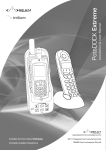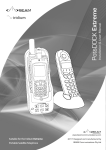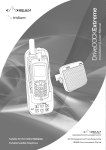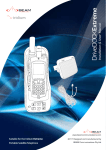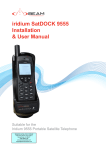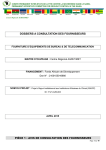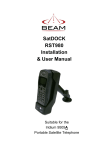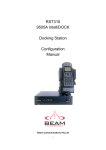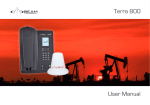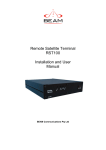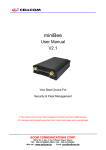Download iridium PotsDOCK 9555 Installation & User Manual
Transcript
iridium PotsDOCK 9555 Installation & User Manual Suitable for the Iridium 9555 Portable Satellite Telephone Beam Communications Pty Ltd iridium PotsDOCK 9555 Installation and User Manual PotsDOCK 9555 Product name: Manual revision: 06 Part Number: USRMAN004706 Release date: April 2013 Information furnished by BEAM Communications Pty Ltd (BEAM) is believed to be accurate and reliable. However, no responsibility is assumed by BEAM for its use, or for any infringement of patents or other rights of third parties, which may result from its use. No license is granted by implication or otherwise under any patent or patent rights of BEAM. BEAM reserves the right to change specifications at any time without notice. Copyright © 2010 BEAM Communications Pty Ltd. All rights reserved User Information Please record your serial number here for future reference: Model: PotsDOCK 9555 Serial no.: This number can be copied from the white label on the PotsDOCK 9555 Eg. PD500001 2 PotsDOCK 9555 Installation & User Manual BEAM Communications Beam Communications, a wholly owned subsidiary of World Reach Limited (WRR), listed on the Australian Stock Exchange, is a world leader in design, manufacture and distribution of specialized communications equipment for the Iridium Satellite Network. Beam’s commitment to be at the forefront has continued to increase its share of the global satellite communications market. Its premium distribution network spans the world. Recognized as a leading provider of satellite communication solutions, Beam specializes in Voice, Data, Tracking and customized solutions. Beam develops innovative products and services to meet market demands and niche applications. Beam’s leading edge products are deployed in a wide range of vertical markets including Maritime, Transport, Government, Defence, Mining, Construction, Forestry, Emergency Services, Relief Aid, Telemetry and Rural Telephony. Supported by a dedicated team of professionals, Beam has developed solid relationships with its peers and network of distributors worldwide. BEAM Communications Pty Ltd 8 Anzed Court, Mulgrave, Victoria, 3170, AUSTRALIA Web:www.beamcommunications.com Info:[email protected] Support:[email protected] Tel: +61 3 8588 4500 Fax: +61 3 9560 9055 3 Conventions in this Manual Warnings, cautions and notes appear throughout this manual and are represented by following conventions. WARNING / CAUTION: This symbol and associated text indicate a warning note providing information to prevent damage to equipment or personal injury. NOTE / IMPORTANT / TIP: This symbol and associated text indicate a note providing general operating information. INTERFERENCE: All wireless phones may get interference, this could affect performance. RECORD: Write details of your unit for easy reference when required. Ideal when troubleshooting. Terminology TERM 4 DESCRIPTION PDMS PotsDOCK Management System - MS Windows Install POTS Plain Old Telephone Service RJ11 Connector type and reference for the POTS telephone port SMS Short Message Service SBD Short Burst Data Mobile Originating Describes a call initiated by the PotsDOCK Mobile Terminating Describes an incoming call being answered by the PotsDOCK 9555 The Iridium 9555 Satellite Telephone On-hook RJ11 POTS Phone handset is hung up. Off-hook RJ11 POTS Phone handset is picked up. ® The ® symbol, mark and logos are owned by the respective companies of which the symbol follows. Any use of such marks by Beam Communications is under license. Other trademarks and trade names are those of their respective owners. REN Ringer Equivalent Number (REN) is a number denoting the electrical load a telephone ringer has on the line. RF Radio Frequencies AT AT tension SMA SubMiniature version A co-axial RF connection PotsDOCK 9555 Installation & User Manual Package Contents Check that your PotsDOCK 9555 package contains: 1 x PotsDOCK 9555 Docking Cradle 1 x AC/DC Power Adaptor 1 x DC Power Cable / Lead 1 x RAM Bracket 3 x M4 Screw Set User Manual Quick Start Guide Optional Accessories The following optional accessories are available for your PotsDOCK 9555 • Beam Privacy Handset Kit (RST755) • Antenna / Cables • Man Down Pendant Kit / Cable Kit •Bluetooth® Audio Headset (RST725) See your service provider for pricing and availability of these quality BEAM accessories. Additional Information For the latest in supporting software and documentation for PotsDOCK 9555 please visit www.beamcommunications.com/support/potsdock9555 DATA To use data on the PotsDOCK, the specific Beam USB driver must be installed on the PC connecting to the PotsDOCK, downloaded from the above link. ALERT/TRACKING To configure the alert / tracking functionality on your PotsDOCK, you must first install the PotsDOCK Management System (PDMS) software, which also includes the specific Beam USB drivers. OTHER RESOURCES AVAILABLE ONLINE - - - - - - Advanced Configuration – inbuilt to PDMS Quick Start Guide & Manual Iridium Direct Internet Antenna Installation Guide AT Command Set 9555 Upgrade if required 5 Contents BEAM Communications 3 Conventions in this Manual 4 Terminology4 Package Contents 5 Safety Information 8 Optional Accessories Additional Information 5 5 WARNING: POTENTIALLY EXPLOSIVE ATMOSPHERES 8 9 Safety – Iridium Transceiver 9555 Electronic Devices 10 Pacemakers10 10 Other Medical Devices Vehicles10 10 Posted Facilities Aircraft10 For Vehicles Equipped with an Air Bag 10 About this equipment 11 12 Equipment Overview: 13 Installation Guidelines 14 Routing Cables (for vehicle installations) Guidelines for Electrical Connections 14 15 Installation Procedure Installing the PotsDOCK Cradle Cradle Mounting Iridium Antenna connection GPS Antenna connection (optional) RJ11 / POTS Telephone (optional) External Alert Button (optional) Privacy Handset (optional – extra order) 16 17 17 18 18 19 19 20 Preliminary Testing Prepare the Iridium 9555 Handset Connect Power Wiring for a Marine Application 21 21 21 22 PotsDOCK 9555 Usage 6 11 POTSDOCK 9555 KEY FEATURES Tracking / Alert Monitoring 23 Docking & undocking your 9555 handset Removing the 9555 from vehicle Call Testing 23 23 24 Bluetooth® Configuration (Optional) Bluetooth® Headset Configuration 25 25 Tracking & Alert Configuration (Optional) 25 Operation of the PotsDOCK 9555 Starting Up Charging the Iridium 9555 Handset 26 26 26 PotsDOCK 9555 Installation & User Manual Placing Voice Calls RJ11 POTS Phone Call – Mobile Originating RJ11 POTS Phone Call – Mobile Terminating A Bluetooth® Phone Call - Mobile Originating Bluetooth® Phone Call – Mobile Terminating 27 27 28 28 29 Privacy Handset Use 29 Mute & Earpiece-Jack Mode Mute functionality Ringer Selection Earpiece-Jack Mode 30 30 30 31 Tracking & Alert Operation Enable Tracking & Alert Send Tracking position Activate Alert Mode Clearing an Alert 31 31 31 32 32 PotsDOCK Front Panel 33 Data Communications Using the USB Data Port USB Driver Installation AT Commands Setting the Baud Rate Iridium 9555 Display Definitions Power-On Messages 34 34 35 36 36 37 38 Assuring Quality of Iridium Service 39 Specification Summary 41 Obstructions39 39 Cabling RF Interference 40 Symptoms of RF Interference 40 40 Mitigation of RF Interference Electrical & Environmental Specifications 41 Cradle Mounting Dimensions PotsDOCK Dimensions in millimeters 43 43 Trouble Shooting 44 Beam Warranty Conditions 47 For additional product support: 46 7 Safety Information IMPORTANT! Please read the following information carefully before installing and using the Beam PotsDOCK 9555. Failing to follow instructions may compromise the safety of the product and may result in personal injury and/or equipment damage. Please consult your supplier if you have any further questions. The PotsDOCK 9555 is a low power docking station for the 9555 handset. When ON, it will charge the 9555 handset whilst docked in the PotsDOCK 9555. Refer to the appropriate section of this PotsDOCK 9555 Installation & User Manual for additional safety information. ◊ Store the system in a cool and dry area. ◊ Do not submerge the system in water. ◊ Do not place foreign metal objects or debris in the system. If debris enters into the system, please return to factory for service. WARNING: DO NOT open equipment. There are no user-serviceable parts inside. If a DC power supply is to be used, its output must comply with the Safety Extra Low Voltage (SELV) requirements of IEC60950. All connectors except the RJ11 line socket must only be connected to equipment ports which comply with the Safety Extra Low Voltage (SELV) requirements of IEC60950. WARNING: POTENTIALLY EXPLOSIVE ATMOSPHERES • Turn your phone OFF and DO NOT remove your battery or remove the 9555 handset from the cradle when you are in any area with a potentially explosive atmosphere. • Obey all signs and instructions. • Sparks from your battery in such areas could cause an explosion or fire resulting in bodily injury or even death. • Areas with a potentially explosive atmosphere are often but not always clearly marked. They include, but are not limited to: »» fuelling areas such as gasoline stations »» below deck on boats; »» fuel or chemical transfer or storage facilities; »» areas where fuel odors are present (for example, if a gas/ propane leak occurs in a car or home); »» areas where the air contains chemicals or particles, such as grain, dust, or metal powders; »» any other area where you normally would be advised to turn off your vehicle engine. 8 PotsDOCK 9555 Installation & User Manual Safety – Iridium Transceiver 9555 Your 9555 handset is a low power radio transmitter and receiver. When it is ON, it receives and also sends out radio frequency (RF) signals. (NOTE: Refer to Iridium 9555 Phone Manual for additional Information) ◊ The Iridium 9555 handset has an in-built Iridium transceiver which is designed to be used with an external antenna. This antenna transmits RF energy. The Iridium antenna (fitted via an extension coaxial cable to the cradle) must be located more than > 0.3 meters (1 foot) from human body (person) when in operation. ◊ International agencies have set standards and recommendations for the protection of public exposure to RF electromagnetic energy. International Commission ♦♦ Protection (ICNIRP) 1996 on Non-Ionizing Radiation ♦♦ Verband Deutscher Elektrotechniker (VDE) DIN-0848 ♦♦ United States Federal Commission, Radio Frequency Exposure Guidelines (1996) ♦♦ National Radiological Protection Board of the United Kingdom, GS 11, 1988 ♦♦ American National Standards Institute (ANSI) IEEE. C95. 1-1992 These standards are based on extensive scientific review by scientists, engineers, and physicians from universities, government health agencies, and industry groups. They review the available body of research to develop ANSI standard. These ANSI standards are reviewed regularly for research development. ◊ Do not operate your satellite telephone when a person is within 1 foot (30 centimeters) of the antenna. A person or object within 1 foot (30 centimeters) of the antenna could impair call quality and may cause the phone to operate at a higher power level than necessary and expose that person to RF energy in excess of that established by the FCC RF Exposure Guidelines. ◊ As a precaution, please maintain the maximum body distance possible from the antenna during call transmission. WARNING: ROAD SAFETY COMES FIRST! Do not use a hand-held cellular terminal, satellite phone or mobile when driving a vehicle, unless it is securely mounted in a holder for speaker phone operation. Before making a call with a handheld terminal, satellite phone or mobile, park the vehicle stationary. Please obey local road laws for hands-free speakerphone operation. Speakerphones (hands-free) must be installed by qualified personnel. Faulty installation or operation can constitute a safety hazard. IMPORTANT! Cellular & Satellite terminals or mobiles operate using radio signals and communication networks. Because of this, the connection cannot be guaranteed at all times or under all conditions. Therefore, you should never rely solely upon any wireless device for essential communications, for example emergency calls. 9 Electronic Devices Most modern electronic equipment is shielded from RF signals. However, certain equipment may not be shielded against the RF signals from your wireless phone. Pacemakers The Health Industry Manufacturers Association recommends that a minimum separation of six inches (6”) be maintained between a wireless phone’s antenna and a pacemaker to avoid potential interference with the pacemaker. These recommendations are consistent with the independent research by and recommendations of Wireless Technology Research. Persons with pacemakers: ◊ Should ALWAYS keep the phone more than six inches from their pacemaker when phone is turned ON ◊ Should turn the phone OFF immediately if you have any reason to suspect interference is taking place Other Medical Devices If you use any other personal medical device, consult the manufacturer of your device to determine if it is adequately shielded from external RF energy. Your physician may be able to assist you in obtaining this information. Turn your phone OFF in health care facilities when any regulations posted in these areas instruct you to do so. Hospitals or health care facilities may be using equipment that could be sensitive to external RF energy. Vehicles RF signals may affect improperly installed or inadequately shielded electronic systems in motor vehicles. Check with the manufacturer or its representative regarding your vehicle. You should also consult the manufacturer of any equipment that has been added to your vehicle. Performance of electronically controlled brake and/or guidance systems can, under certain unique conditions, be subject to interference by mobile radio operation. Although the transceiver exceeds all requirements regarding RF emissions, you should mount the transceiver as far as possible from the guidance system and/or braking modulator box (usually located in the trunk) to minimize any interference. Posted Facilities Turn your phone OFF in any facility where posted notices require such as hospitals and on-board aircraft. Aircraft Airline regulations prohibit using your phone while in the air. Consult the local Aviation Authority for guidelines on use of the equipment on board an aircraft. For Vehicles Equipped with an Air Bag An air bag inflates with great force. Do NOT place objects, including both installed and portable wireless equipment, in the area over the air bag or in the air bag deployment area. If in-vehicle wireless equipment is improperly installed and the air bag inflates, serious injury could result. 10 PotsDOCK 9555 Installation & User Manual About this equipment POTSDOCK 9555 KEY FEATURES POTSDOCK CRADLE • • • • • Securely holds 9555 handset Robust design and construction Charges 9555 handset ready for use Integrated antenna connection Integrated USB connectivity POTS/RJ11 • Supports standard cordless & corded telephones (5 REN) • The POTS phone can be run 600m (2000 ft) from unit • Easily integrated to PBX system • Ring, busy & dial tones • Superior voice quality TRACKING/GPS • • • • • In-built GPS engine Tracking & alert monitoring capable Periodic position reports or remotely polled Triggered position status message Also compatible with other tracking applications PANIC/ALERTS • Panic Alert button in-built to cradle • Option of additional wired alert buttons INTEGRATED BLUETOOTH® • Bluetooth® in-built in cradle • Supports Bluetooth® voice & data connectivity IN-BUILT RINGER • In-built ringer for enhanced ring indication VOICE, DATA, SMS, SBD • Supports all Iridium voice, data, SMS & SBD services • Access to prepaid, post paid & crew calling PRIVACY HANDSET • Supports optional Beam privacy handset • Auto sensing answer/hang-up intelligence INSTALLATION • Supports 9 - 32V DC power input • Flexible installation via universal mount, also suitable for wall mounting • Supplied with 110 - 240V AC/DC Plug pack QUALITY • Professional industrial design • 2 year replacement guarantee for peace of mind • 100% factory tested • Full certified, Iridium, RoHS, CE, IEC60945, AS/EN60950 PotsDOCK 9555 is an intelligent compact docking station specifically designed for the Iridium 9555 satellite handset. PotsDOCK allows the 9555 handset to be used in a wide variety of applications. It enables you to use an intelligent RJ11/POTS connection with a standard corded, cordless or DECT handset. Alternatively, it can also be interfaced with a PBX system. PotsDOCK also has an in-built Bluetooth® module for voice and data connectivity. Equipped with internal GPS, the PotsDock provides an intelligent tracking and alert reporting system that can be easily configured to support periodic polling or emergency alert reporting. 11 Tracking / Alert Monitoring PotsDOCK has an in-built GPS module that can provide simple tracking, monitoring and alert management in various land and sea based applications within various types of vehicles, vessels or fixed site locations. The GPS module provides pinpoint accuracy and enables tracking worldwide. The tracking function has to be configured and enabled on the PotsDOCK via the PDMS. Once turned on, tracking and alert messages can be sent to a phone number, e-mail address, or tracking application via SMS or Short Burst Data (SBD) if configured on the 9555 handset. Tracking messages can be sent from the PotsDOCK in the following ways; 1. Periodic position reporting, which is preset during configuration of the PotsDOCK 2. A current location position can be sent at any time by pressing the Track button on the front of the PotsDOCK The Alert mode can be activated on the PotsDOCK in the following ways; 1. Use the two button press (know as the Alert button) on the front of the cradle 2. Use an external alert button/emergency push button connected to the alert loop Once activated, alert messages will be sent to the preset destination continuously until the alert is disabled either remotely or locally on the PotsDOCK unit. 12 PotsDOCK 9555 Installation & User Manual Equipment Overview: EJECT Button 9555 Handset Antenna Plug RJ11 Port Mini USB Data Port 3-Button Panel Interface Iridium Antenna (TNC Female) GPS Antenna (SMA Female) Privacy Handset (4-pole, 3.5mm) Input Power (4-way Microfit) Alert Loop (In/Out) 13 Installation Guidelines This guide outlines the process for installing the Beam PotsDOCK 9555 in conjunction with an Iridium 9555 portable handset. This kit must not be used with any other device other than the Iridium 9555 handset. ◊ Only qualified personnel should install communication equipment. If necessary, contact the vehicle manufacturer for air bag information specific to the vehicle. ◊ Ensure that the units are protected from dirt and moisture. ◊ Select an area to mount components that do not interfere with driver or passengers seating or leg space. ◊ Ensure that each mounting surface is strong enough to support the component being mounted to prevent the component from loosening over time. ◊ Mount all components securely to prevent shifting that could cause injury or could interfere with safe vehicle operation. Always use the supplied mounting hardware. ◊ Leave space around the units to allow cooling and ensure there are adequate clearance for cables. ◊ Ensure the units can be easily removed. Routing Cables (for vehicle installations) If your vehicle is equipped with wiring troughs in the doorsills, use them to simplify cable installation and to provide maximum protection for the cables. If wiring troughs are not available, route cables according to these guidelines: ◊ Route cables so they are protected from pinching, sharp edges, and crushing WARNING: Air bags inflate with great force. DO NOT place objects, including communication equipment, in the area over the air bag or in the air bag deployment area. If the communication equipment is improperly installed and the air bag inflates, serious injury could result. ◊ Where possible, avoid routing cables above the catalytic converter ◊ Use grommets wherever a cable must pass through a hole in a metal panel ◊ In a vehicle equipped with electronically controlled anti-skid brakes, route all cables on the opposite side of the vehicle from the braking modulator box to minimize possible interference from the phone. ◊ Keep all in-line connectors accessible. ◊ The suggested path for routing cables in vehicles without wiring troughs is alongside the drive shaft hump, under the carpet. 14 PotsDOCK 9555 Installation & User Manual Guidelines for Electrical Connections The system is designed to operate in negative ground 9 to 32 Volt DC electrical systems only. IF using the DC cable lead: ◊ The best power connection point for the positive primary power leads is the positive terminal of the vehicle battery. Often, direct connection to the battery is inconvenient, and you may find it easier to connect the positive leads to the starter solenoid. Always select a point as close as possible to the battery. ◊ Connect the negative primary power leads to a good ground point on the vehicle chassis or at the battery. If you must attach the negative primary power lead(s) directly to the negative pole of the battery, you may optionally insert a 10-amp fuse (not included) into the ground (0V) line. Failure to insert a fuse can cause equipment to overheat IF a wiring fault exists. ◊ Many parts of a vehicle can produce electrical noise that interferes with the electrical radio system operation. The ignition system is the most common source of electrical noise interference. Before you begin installation, ensure that the ignition wiring and connections to the vehicle battery are in good working condition. ◊ Verify that low resistance connections are present between the battery negative terminal, the vehicle chassis, and the engine block. All wire connections should be clean and tight. At 13.6 volts, the PotsDOCK cradle draws a maximum of 1 amp current. Please ensure that the vehicle’s battery and alternator have sufficient current capacity to deliver at least 1 amp more than the maximum current that may be required by the vehicle and its other accessories. WARNING: Do not connect the PotsDOCK interface power cable to power the unit until the full installation is completed. 15 Installation Procedure Installing the PotsDOCK Cradle Install the components in the following order. More detailed instructions can be found in the sections following. 1. Mount the PotsDOCK cradle 2. Install the external Iridium and/or GPS antenna (ordered as extra option) 3. Install the (optional) 4. Install the privacy handset (ordered as extra option) RJ-11 Pots telephone 5. Install the external alert button (option) 6. Connect power to the PotsDOCK cradle 7. Configure Bluetooth® (optional) 8. Configure Tracking / Alert (optional) When selecting a location for the PotsDOCK cradle, consider these guidelines: ◊ Ensure that each mounting surface is strong enough to support the cradle. ◊ Allow enough room so that you can easily insert the 9555 handset into and remove it from the cradle. ◊ Ensure that the PotsDOCK is within cable distance of power and antenna connections ◊ Position the handset and cables so that it does not interfere with vehicle operation or with driver or passenger seating or leg space. ◊ Ensure sufficient room is allowed for the antenna and interface cables to be routed from the rear of the PotsDOCK. 16 PotsDOCK 9555 Installation & User Manual Cradle Mounting The PotsDOCK is supplied with a universal RAM®-mount bracket that enables mounting to any flat surface (vertical or horizontal) within a vehicle, attached on a wall or on a table as required. 1. Attached one pivot base to the rear of the PotsDOCK using the M4 screws supplied. Pivot base bolted on 2. 3. Secure the second pivot base to the location you have selected for mounting the PotsDOCK. Pivot Base RAM Mount Use the interconnecting stem of the RAM mount to secure the PotsDOCK to the pivot base and tighten into the desired location firmly using the wing nut on the stem. Finished result 17 Iridium Antenna Connection The antenna connections exits from the rear of the PotsDOCK cradle, via the antenna loom as shown in the picture. Install the Iridium antenna in the appropriate location (with clear sky view) and then connect it to the TNC female connector on the antenna cable coming from the rear of the PotsDOCK. WARNING: DO NOT pull with force on the cables from the rear of the PotsDOCK. Please install strain relief clamping for the antenna cables where required. Correct installation of the antenna system is a vital part of the PotsDOCK system, to ensure reliable functionality, and drop-free calls. Use only quality low-loss antenna cabling, and ensure that the cable(s) and connectors to the antenna provide no more than 3dB attenuation (at frequency of 1.6GHz) NOTE: Refer to the section “Assuring Quality of Iridium Service” for more information on antenna placement and installation GPS Antenna Connection (Optional) The GPS connection is optional if the tracking function is not required. If connected, and tracking is enabled, position or location information will be shown on your tracking messages and alert messages. The GPS connection supports an active GPS antenna compatible with powering from a 3.3V source. Install the GPS antenna in the appropriate location and then connect it to the SMA female connector on the antenna cable coming from the rear of the PotsDOCK. 18 PotsDOCK 9555 Installation & User Manual NOTE: Antenna should only be connected and disconnected to the GPS receiver when the PotsDOCK is not powered. Connecting the antenna after power-up can result in prolonged acquisition time. RJ11 / POTS Telephone (Optional) Any standard analogue POTS Telephone (POTS = Plain Old Telephone Service) is supported by the PotsDOCK. It supplies power to the analogue phone as well as Ring, Dial and Busy tones. 1. Route the telephone cabling (up to 600m) from the PotsDOCK. 2. Mount the analogue phone if required, and plug the RJ11 cable into the PotsDOCK RJ11 port. The RJ11 port uses the middle 2 pins of the RJ socket, which is standard for analogue telephone cables. External Alert Button (optional) PotsDOCK provides an additional cable pair from its rear cable loom, known as the standard Beam alarm-loop. This provides a Normally-CLOSED wire loop, which can be used to connect to any passive type of button, or relay, or reed switch in which the action breaks the loop (OPEN) to activate the alarm state. Connect the BROWN and GREEN wires either directly to the button, or it can be extended for longer runs (up to 45 meters). This alarm loop can support multiple alarm buttons / switches – wired in SERIES, whereby any one of these buttons will OPEN (activate) the loop when pressed. To properly register the alarm state, the loop needs to be OPEN for at least 2 seconds – (ie. holding down the button for 2 seconds activates the alarm). 19 Privacy Handset (Optional – Extra Order) The PotsDOCK provides a 4-pole 3.5mm audio socket on the rear cable loom, for connection to the Beam privacy handset. This provides local handset function, conveniently mounted next to the PotsDOCK cradle. 1. The Privacy Handset Kit (purchased/ordered separately) contains a mounting bracket, space plate, and fasteners. 2. Mount the handset cup to the mounting plate. 3. Mount the spacer plate and the mounting bracket to the rear of the PotsDOCK, by using the longer screws provided with the kit. The original RAM arm-bracket plate is also re-installed behind these plates. 4. Plug the Privacy Handset 4-pole connector into the rear cable loom. (Please use suitable electrical tape and/or strain relief clamps where required to ensure reliable connection) Privacy Handset mode is enabled when the handset is removed from the cup. Please ensure to re-dock the Privacy Handset when not in use. 20 PotsDOCK 9555 Installation & User Manual Preliminary Testing Prepare the Iridium 9555 Handset 1. Ensure that the 9555 Handset is running with the required compatible firmware which can be located at: www.beamcommunications.com/support/potsdock9555 2. Remove the rubber plug / bung / grommet from the rear of the 9555 Handset, to reveal the antenna socket hole. WARNING: Ensure that the external antenna grommet at the rear of the 9555 handset is removed prior to inserting the handset into the PotsDOCK cradle. Connect Power Once all the components are installed, apply power to the PotsDOCK via the 4-way Microfit connector using the AC/DC power adaptor or the DC power cable. A: Power from the AC/DC Adaptor If the PotsDOCK is used inside a building where mains power is available, it can be powered from the AC/DC power adaptor. The supplied AC/ DC power adaptor supports international AC voltage ranges for global compatibility. Please follow the steps below to connect the power. 1. Ensure that the power adaptor cable has enough length to reach the PotsDOCK cradle and it is plugged into a power outlet of suitable safe power capability. If using a power-board extension, please ensure that it is not overloaded. 2. Connect the 4-way output connector from the power adaptor to the matching 4-way connector from the rear cable loom of the PotsDOCK cradle as shown below. Please note that while the PotsDOCK is powered by the AC/DC adaptor, it will always be turned ON unless power is removed. 21 B: Power from the DC Power Cable The DC power cable can be used where the mains AC power is unavailable, for example, in a vehicle. The PotsDOCK can be powered from a 9 to 32V DC power source and the vehicle battery falls well into the range. The DC power cable has three wires, RED, BLACK and YELLOW. The RED and BLACK wires are used for the power connection while the YELLOW wire can be connected to a vehicle’s accessories, ignition or other similar circuits to control the ON/OFF status of the PotsDOCK in synchronization with a vehicles operation. By default, the PotsDOCK will stay on for 20 minutes after this input is switched off and if a call is in progress while this occurs, the PotsDOCK will stay on for 20 minutes after the call is terminated. Please follow the steps below to connect the DC power cable to the vehicle battery power and the PotsDOCK. 1. Connect the 4-way Microfit connector on the DC power cable to the 4-way power connector on the rear cable loom of the PotsDOCK. 2. Route the other end of the DC power cable to the connection point. DO NOT apply power until the following steps are completed. 3. Connect the BLACK wire to the negative terminal of the battery or the vehicle chassis (if negatively grounded chassis). 4. Connect the RED wire to the positive terminal of the battery. It is recommended to add a 3A fuse between them. 5. RED (+) Vin 9 to 32VDC BLACK (-) OV Power Ground YELLOW (IGN) Ignition / Accessory To Battery Positive Terminal (3A Fuse recommended) To Negative Terminal or chassis To ACC switched power (1A Fuse recommended) Connect the YELLOW wire to the vehicle accessory power. If the accessory power is unavailable, this may be connected to a vehicle ignition voltage. It is recommended to add a 1A fuse between them. The accessory wire enables the PotsDOCK to turn on and off as the vehicle key is enabled or disabled. If this function is not required, the YELLOW wire MUST be connected to the RED wire. Wiring for a Marine Application When installed in a marine application using the DC power cable, the YELLOW wire can be wired to a suitable panel switch which will allow the PotsDOCK to be turned off when not in use. 22 PotsDOCK 9555 Installation & User Manual PotsDOCK 9555 Usage Docking & undocking your 9555 handset 1. To dock the 9555 handset place the base of the 9555 handset into the seat of the PotsDOCK ensuring that the pins on the bottom of the 9555 handset line up with that on the seat of the PotsDOCK cradle. 2. Push “EJECT” button located on top of the cradle and press the phone in firmly at the same time. Gently pull on the handset to confirm that it is docked correctly and won’t come loose. Removing the 9555 1. When removing the 9555 handset from the PotsDOCK cradle, reverse the above steps, ensuring you firmly press the “EJECT” button on top of the PotsDOCK cradle. The phone will then pop forward into your hand and can then be removed from the cradle. (The “EJECT” button requires firm force to release the phone) 23 Call Test To confirm that the PotsDOCK is working properly, you can make a call using an RJ11 analog telephone. 1. Connect an analog telephone to the RJ11 connector at the bottom of the PotsDOCK cradle. 2. Apply power to the cradle using the AC/DC power adaptor or the DC power cable. 3. Dock a working 9555 handset into the cradle. You should hear a startup beep sound and the 9555 will be turned OFF and then ON depending on its status. 4. Once the 9555 shows registered on the Iridium network, off-hook the analog telephone and listen for the dial tone. 5. Dial a number (using the full country codes) on the telephone keypad. 6. Allow up to 5 seconds for the call to be issued to the 9555 handset, at which point the following message will appear on the 9555 display. 7. “DPL Call in Progress” 8. Test the audio in both direction and then hang up the call (on-hook). 9. Now make a call from your landline phone or mobile phone to the 9555 handset. You need to know the phone number of the SIM card used in the 9555 handset. 10. On incoming, the PotsDOCK internal ringer will sound and the analog telephone should also ring. 11. Pick up the analog telephone (off-hook) to answer the call and check audio in both directions and then hang up the call. 24 PotsDOCK 9555 Installation & User Manual Bluetooth® Configuration (Optional) PotsDOCK has an in-built Bluetooth® module for voice and data connectivity. The factory default power mode is Class 2 (at least 10 metres) low power. Bluetooth® Headset Configuration To configure/pair to a Bluetooth® headset (audio) device: 1. Power up the PotsDOCK cradle. 2. on the cradle for 5 Press and hold the Bluetooth® button seconds, until the cradle sounds a double (2) beep. The Bluetooth® LED will then flash BLUE and ORANGE. 3. Hold the headset (device) button(s) to enter the pairing mode (please refer to the headset user manual). 4. Once the devices are successfully paired, the Bluetooth® LED on the cradle will change to BLUE (half intensity). 5. Bluetooth® can be turned ON with a single press, and OFF by for 2 seconds pressing and holding the Bluetooth® button on the cradle. The cradle will sound a single (1) beep when turning off. Once paired, the PotsDOCK will automatically connect to this device every time the PotsDOCK powers up. You may repeat this process to pair more than one headset (up to 17 total devices including data, such as; email, sms and sbd) – ensure only one device is switched on during subsequent pairing configuration. Tracking & Alert Configuration (optional) Tracking & Alert requires the installation of a GPS antenna, and setup of the tracking and/or alerting messages. Please refer to the PDMS software to enable and configure Tracking & Alert. NOTE: If the external alert loop is going to be used with an external button, remember to enable this external loop in the PDMS settings. Once enabled, the loop will be armed and activated with an open-loop condition. To avoid false triggering, be sure to have the normally-closed button wired into the alert loop, before applying power. 25 Operation of the PotsDOCK 9555 Starting Up 1. Retract the antenna on the 9555 handset. 2. Place the 9555 handset into the PotsDOCK as per instructions “Docking & Undocking” on page 25. 3. If using the YELLOW accessory input wire, switch the vehicle ignition to ACC or ON position, The PotsDOCK and the 9555 handset will automatically power up and the PotsDOCK internal ringer will produce a power-up beep. 4. Wait for the 9555 handset to register on the Iridium network. 5. You are now ready to make and receive calls. NOTE: If the 9555 handset fails to connect with the cradle, the cradle will power cycle the 9555 twice when it is docked and after that, it will power down the 9555 and put it into a one-minute charge mode with the Ring/Mute LED flashing RED and GREEN. After the one minute, the cradle will try again to connect with the 9555. If it still fails, the cradle will follow the above sequence however for a 10-minute duration. One common cause for connection failure is a flat 9555 battery which prevents the 9555 from being turned on in the cradle. The one-minute and ten-minute charge cycle will ‘resurrect’ the battery and once the 9555 is connected with the cradle, charging will resume on the 9555. If the 9555 handset is removed from the cradle during the charging process, then reinserted, the startup process will restart from the beginning. Please be patient during this startup sequence. Ringer / Mute LED will flash RED and GREEN during above charging process. NOTE: The 9555 handset can be removed whilst powered, however the handset will turn off automatically. If it is removed during a call, the 9555 will attempt to remain in call (as long as antenna is extended and in sky view). The call may drop out during this transition, and the phone may turn off. Charging the Iridium 9555 Handset The PotsDOCK provides charging power to the 9555 handset via its base connector. Therefore, DO NOT plug another power supply into the 9555 side power port whilst it is docked in the cradle. The 9555 battery is a lithium-ion cell which has a safety temperature range whilst charging. This range is from 0 to 40 degrees Celsius (32 to 104 degrees Fahrenheit). 26 PotsDOCK 9555 Installation & User Manual Due to the increased heating effects on the 9555 handset whilst it is docked and being charged, it is ideal for the ambient temperature to be approximately 10 degrees below the 40 degreeC upper limit for the handset to charge the battery whilst docked. If the battery temperature exceeds this limit, then the 9555 may cease charging until the temperature is reduced. In some cases, the charging process may oscillate ON and OFF at the temperature limit. This could damage the Li-ion battery. To avoid the charging oscillation, the PotsDOCK employs a pulse powering mechanism to charge the 9555. Basically, charging power will be provided to the 9555 for a pre-defined duration (default 40 minutes) and then removed for another pre-defined duration (default 20 minutes). By turning off the charging for some time, it allows the 9555 battery to cool down and during the OFF period, if the temperature drops below a pre-defined level (default 28 degreeC), the PotsDOCK will immediately turn on the charging power before the OFF timer expires. The charging ON, OFF and temperature level are configurable via the PDMS. Placing Voice Calls A. During call, you may transfer the call to the optional privacy handset by taking the privacy handset out of its cup. This automatically directs the call audio to the privacy handset. To return the call back to the RJ11 Phone, insert the privacy handset back in its cup. B. During call, you may transfer the call to the optional Bluetooth® audio headset by a single short press of the Bluetooth® button on the cradle. The Bluetooth® LED will start slow-flashing in BLUE to indicate the Bluetooth® device is in use. To return the audio back to the RJ11 phone, perform another single short press of the Bluetooth® button on the cradle. The Bluetooth® LED will turn solid BLUE. NOTE: Country codes are not required if “Call Processing” is enabled in the PDMS 27 RJ11/POTS Phone Call – Mobile Terminating 1. The RJ11/POTS phone will sound its ringer, according to the settings for ringer in the PDMS. 2. Lift the RJ11/POTS phone handset (off-hook) to answer the call. Once the call is in progress, options A and B from “RJ11 POTS Phone Call – Mobile Originating” section on page 29 are also applicable. NOTE: The PotsDOCK internal ringer will also sound during an incoming call. This can be changed by a single press of the Ringer button, whilst out of call. (Please refer to the section “Ringer Selection” for more details.) A Bluetooth® Phone Call - Mobile Originating A Bluetooth® call can be started by using the 9555 keypad. 1. Ensure that the Bluetooth® audio headset is connected with the PotsDOCK, i.e. the Bluetooth® - half intensity. 2. LED is turned on in BLUE Dial the phone number (using the full country code) on the 9555 keypad or press the Call button on the Bluetooth® headset which will then dial the last called number. The message “Call in Progress” will appear on the 9555 display and the audio is automatically routed to the Bluetooth® headset. During the call, the Bluetooth® LED will flash slowly in BLUE. 3. Press the RED key on the 9555 handset to terminate the call. Options: A. During a call, you may transfer the audio to the optional privacy handset by removing it out of its cup. This automatically directs the call audio to the privacy handset. To return the call back to the Bluetooth® headset, put the privacy handset back in its cup. 28 PotsDOCK 9555 Installation & User Manual Bluetooth® Phone Call – Mobile Terminating 1. Ensure that the Bluetooth® audio headset is connected with the PotsDOCK, i.e. the Bluetooth® - half intensity. 2. LED is turned on in BLUE Answer the incoming call by: ♦♦ Pressing the Bluetooth® headset answer button OR: ♦♦ Pressing the GREEN key on the 9555 keypad. 3. To end the call: ♦♦ Pressing the Bluetooth® headset answer button OR: ♦♦ Pressing the RED key on the 9555 keypad. Once the call is in progress, Option A from “A Bluetooth® Phone Call – Mobile Originating” secion on page 30 is also applicable. Privacy Handset Use The Beam privacy handset (RST755) is an optional accessory which can be ordered separately. The privacy handset mode is enabled when the handset is removed from its cup. The Ring/Mute LED will start flashing in ORANGE to indicate the privacy handset is enabled. Please re-dock the privacy handset when not in use and the Ring/Mute LED will be turned off. The privacy handset is an audio only device, with no means to dial a number. It can be used to answer a call by removing the handset from its cup but not make a call. To originate a call from the privacy handset, you need to un-cup it and then dial the number from the 9555 keypad. When the privacy handset is used to originate or answer a call, the RJ11/POTS interface will be disabled. Therefore if you un-hook the connected POTS phone while the privacy handset is in use, you will hear an unavailable tone. However, you can still transfer the audio to a connected Bluetooth® headset by pressing the Bluetooth® button. 29 Mute & Earpiece-Jack Mode Mute functionality The mute function of the PotsDOCK allows the user to mute either the RJ11, Bluetooth®, or privacy handset audio to the 9555 handset whilst docked in the PotsDOCK. 1. button on the face of the During a call, Press the Mute PotsDOCK, a RED LED will illuminate at the Mute button to confirm that the PotsDOCK is muted. 2. To exit the mute mode, press the mute button once. NOTE: Mute function only operates DURING a call. Once the call is ended, Mute mode is exited. If the Mute button is pressed when NOT in call, it will step through the Ringer Volume modes. Ringer Selection The PotsDOCK has an internal ringer that sounds during an incoming call. There is a choice of two (2) ring tones: ♦♦ Repeating two-tone cadence ♦♦ Single beep at beginning of incoming call These modes can be changed by single press of the Ringer button, when OUT of call. A preview of the sound will be heard, and the setting is stored. Press again to switch between the 2 choices. 30 PotsDOCK 9555 Installation & User Manual Earpiece-Jack Mode The PotsDOCK allows a user to utilise a 2.5mm earpiece plugged into the right side of the 9555 handset. 1. During a call, to enable Earpiece-Jack Mode, press and hold the Mute button for 1.5 seconds. The LED on the mute button will start flashing ORANGE to indicate that the PotsDOCK is in Earpiece-Jack mode. 2. To exit the Earpiece-Jack Mode, press the Mute button once. NOTE 1: The 2.5mm jack can remain plugged into the 9555 handset whilst in normal or Earpiece-Jack mode. NOTE 2: The Earpiece-Jack function only operates DURING a call. Once the call is ended, the 9555 will exit the Earpiece-Jack mode. If the Ringer button is pressed when NOT in call, it will step through the Ringer Volume modes. NOTE 3: The Earpiece-Jack mode automatically enables when a call is placed (on the 9555 keypad), and both the RJ11 POTS is on-hook, the privacy handset is cupped and the Bluetooth® mode is off. An incoming call can also be answered in the Earpiece-Jack mode by pressing the Ringer key on the 9555 handset. button, or by pressing the GREEN Tracking & Alert Operations Enable Tracking & Alert The Tracking & Alert function is not enabled by default and it has to be configured and enabled using the PDMS software via the mini-USB connection to the PotsDOCK. Various configuration options are available to the user in the PDMS. The message delivery method is also set using the PDMS. Please refer to the PDMS User Guide for more details on how to configure and enable the Tracking & Alert function on the PotsDOCK. Send Tracking Position In order to send a tracking message, the following condition must be fulfilled. 1. The GPS receiver has acquired enough satellite signals and navigational data to calculate a positional solution (fix). 2. The 9555 handset is registered with the Iridium network. 3. Tracking is configured and enabled via the PDMS) 31 The Track LED will stay off if the Tracking function is disabled. It will turn solid GREEN if all of the above conditions are satisfied. Otherwise, it will flash in GREEN if the Tracking function is enabled but no GPS fix and/or Iridium registration. To manually send a tracking message of the current location 1. Apply a single press to the Track configured in the PDMS). button. A beep will sound (if Activate Alert Mode Alert mode can be activated by one of the following two methods: 1. + Ring/Mute buttons together Press and hold the Track for 2 seconds. A single beep will sound (if configured in the PDMS). 2. If enabled by the PDMS, press and hold the external panic button (optionally wired into the Alert Loop wires). Once triggered into the Alert mode, the Track LED turns RED. The message then attempts to be sent. The Track LED will flash in RED when the alert message is sent. (Rate: 1.5sec off, 1.5sec on, etc) The Track LED will flash in ORANGE when the alert message is acknowledged by a remote host. (Rate: 1sec off, 4sec on, etc) Clearing an Alert To clear the alert mode press and hold the Track button for seven seconds. A single beep will sound, and the LED will show re-armed state (GREEN). 32 PotsDOCK 9555 Installation & User Manual PotsDOCK Front Panel BUTTON BUTTON MODE LED/SOUND Out of Call: Select Ringer Tones LED off. Preview and select ringer sounds. During In-Call RJ11 or Bluetooth®: Mute (single press) LED is RED when MUTE. During In-Call RJ11 or Bluetooth®: LED flashes ORANGE. Earpiece-jack (1.5 seconds press) Subsequent single press, exits Earpiece-jack Bluetooth® On (single press) LED is BLUE (half intensity) when Bluetooth® ON and is connected LED is fast-flashing in BLUE when searching paired device. Bluetooth® OFF (1.5 seconds press) LED is slow-flashing BLUE when a connected Bluetooth® device is in use. Single beep sounds when Bluetooth® turning OFF. Discovery Mode (5 seconds press) LED flashes ORANGE and BLUE. Clear Bluetooth® Devices (10 seconds press) Ringer sounds triple (3) beeps. Send Tracking Message (single press) LED and beep operates according to the settings in PDMS. Clear Alert Mode (7 seconds press) LED turns GREEN re-armed & GPS fix ready. Single Beep sounds. Ringer sounds double (2) beeps. If LED is flashing in GREEN – No GPS fix, or no Iridium signal LED is OFF when Track & Alert is disabled. Activate Alert Mode (2 seconds press, BOTH buttons together) + Track LED turns RED when alert is triggered and single beep sounds. Track LED is flashing in RED when the alert message is sent. Track LED is flashing in ORANGE when the alert message is acknowledged by a remote host. 33 Data Communications The PotsDOCK provides the convenience of accessing Iridium data services via the mini-USB connector located on the bottom of the cradle while the 9555 handset is docked. You should consult your service provider for full details on the availability of this service with your account. Data communication with the 9555 handset provides the following: ◊ Ability to issue AT commands directly to the 9555 ◊ Undertake Circuit Switched Data (CSD), Short Burst Data (SBD) and Short Message Service (SMS) communication when services are provisioned. ◊ Access the internet via Iridium Direct Internet 2 or through a Dial-Up connection TIP: Learn more about Data Services available at: www.beamcommunications.com Using the USB Data Port The Iridium 9555 handset provides a mini-USB port on its side that allows connection to a PC or laptop for data communication purpose. For more information on using the 9555 handset’s USB port, please refer to the 9555 handset user manual. When the 9555 handset is docked in the PotsDOCK cradle, its USB data function is available through the mini-USB connector, on the bottom of the PotsDOCK, as shown below. NOTE: When the 9555 is docked in the PotsDOCK cradle DO NOT use the USB port on the side of the 9555. Please use the provided USB port on the underside bottom of the cradle to ensure correct PotsDOCK synchronization and operation. Mini-USB Data Port To connect a PC/laptop to the PotsDOCK bottom mini-USB port, you will require a mini-USB-B to USB-A data cable. This cable is included in your original 9555 package. 34 PotsDOCK 9555 Installation & User Manual USB Driver Installation The PotsDOCK 9555 USB data port requires an interface driver to be installed on the user’s computer prior to undertaking data communication. This driver supports the following operating systems: Windows 2000, Windows XP, & Windows Vista You can download the Windows driver for the PotsDOCK 9555 from http://www.beamcommunications.com/support/potsdock9555 Please note that Iridium only supplies Direct Internet 2 software for the Microsoft Windows-based operating system. After the driver is successfully installed, a new serial port should appear in the Ports (COM & LPT) section of the Windows Device Manager as shown below. 35 AT Commands When utilizing the USB data communication port, the PotsDOCK cannot activate AT commands that could interrupt the PotsDOCK’s synchronization with the 9555 handset. Therefore, the PotsDOCK will block or limit AT commands that could cause any adverse effects to the functional operation of the cradle. Please refer to the Iridium “ISU AT Command Reference” document for more details on the AT commands supported by Iridium. www.beamcommunications.com/support The document is located under common resources then “Iridium AT command guide.” And can be downloaded for your convenience. The following AT commands are affected: AT COMMAND CRADLE DEFAULT STATUS LIMITATION AT+IPR 6,0 Auto-baud is permanently disabled with the default baud rate set to 19200. ATEn 1 Echo is on permanently enabled ATVn 0 Numerical responses only AT&Cn 0 DCD is forced on at all times ATQ1 1 ISU responses are not sent to the DTE AT&F0 - Blocked AT&W1 - Blocked AT&Yn - Blocked Setting the Baud Rate If you wish to access the serial port at a different baud rate please issue the following AT command: AT+IPR = <rate> [,<autobaud>] Example: AT+IPR=5,0 This will set the baud rate to 9600 bps with autobaud disabled and will take effect immediately. 36 PotsDOCK 9555 Installation & User Manual Iridium 9555 Display Definitions Display Status indicators and Icons The following icons will appear in your 9555 handset display to provide you with various information about the phone’s activity. Main Screen Components Menu Components 37 Power-On Messages Once your phone is powered on, you may see: MESSAGE DESCRIPTION 38 Searching... Your phone is attempting to establish communications with the satellite network. Registering... Your phone is registering with the network. When the process is complete, you will see Registered. Check Signal Your phone is unable to establish registration with the satellite network. Move to a location with a clear unobstructed view of the sky. Invalid Account Contact your service provider. Enter Phone Unlock Code Your phone was locked after the last use. Enter your four-digit unlock code and press OK to proceed. Enter PIN Enter the four- to eight-digit SIM card PIN code provided by your service provider and press OK to proceed. Insert Card Power off your phone, make sure your SIM card is inserted completely, and then power your phone on again. Check Card The SIM card is damaged or inserted the wrong way. Blocked If the SIM card PIN code is incorrectly entered three times in a row, your phone becomes blocked. Use **05* to proceed to enter the PUK code. Contact your service provider for further details. ! Blocked If the SIM card PIN2 code is incorrectly entered three times in a row, some features (e.g. Fixed dialling) become blocked. Contact your service provider for further details. Bad Card See Supplier Your SIM card has been damaged or incorrectly issued. Contact your Service Provider for information. Busy Try Later OR Please Try Later The phone is unable to access the network. Try again in a few minutes. Restricted Area The phone is unable to access the network. Move to an area where calls are allowed. Redial? Press OK to redial the number automatically. PotsDOCK 9555 Installation & User Manual Assuring Quality of Iridium Service Iridium is committed to providing subscribers around the world with consistent, reliable, quality voice and data access all day, every day. The Iridium satellite system is monitored for call performance from numerous locations 24 hours a day, 7 days a week in order to achieve this. There are conditions that can compromise the quality of the service you may receive. These include: ◊ Obstructions ◊ Cabling ◊ RF Interference Obstructions The antenna must be able to “see” the entire sky from approximately 8 degrees above the horizon. Nearby tall buildings or similar structures, heavily leafed trees and mountains can all degrade performance as they block the signal between the antenna and the satellites. Having a completely open view of the sky plays a very important role in maximising performance, as the Iridium satellites cross the sky from North horizon to South horizon during a connected call. All surrounding obstructions must be lower than the top of a fist extended at arms length and the bottom of the fist placed on the horizon. Iridium performance is immune from natural environments such as clouds, fog, rain, snow, wind and smoke. l Visibility Ful 8.2° Cabling Using an externally mounted antenna provides an ideal solution for many applications. If you have or plan to install an external antenna, it is very important that the cables used meet the Iridium guidelines established for proper performance. For optimal performance, we recommend using the shortest length of cable and the fewest number of connectors possible. 39 RF Interference All wireless devices, including satellite telephones, are susceptible to RF (radio frequency) interference from other electronic devices. This problem is more evident when numerous antennas and broadcasting devices are located within close proximity to each other. Symptoms of RF Interference Symptoms of RF interference often resemble those that arise when an Iridium phone is being operated with an obstructed view of the sky. Some of these symptoms include; erratic or no signal strength indication dropped calls or warbled or otherwise distorted voice. These symptoms may be intermittent or persistent, depending largely on the interference source, its distance, strength and frequency relative to the Iridium unit. Mitigation of RF Interference Iridium Service degradation due to RF interference can be significantly improved by: a.Increasing the distance and moving the Iridium antenna off axis from the source of the interference, and b.Using an external band pass filter and an external antenna. 40 PotsDOCK 9555 Installation & User Manual Specification Summary Electrical & Environmental Specifications POWER SPECIFICATIONS Rated Input 9-32V DC, 2A max AC Power Pack 90-250V AC 50-60Hz, Output 12V 45W Average Power Consumption CurrentPower @ 12V Watts Standby, *handset + RJ11 90mA Transmit, handset + RJ11 0.5A 6W Sleep Mode 25mA 0.3W 1.1W INTERFACES RJ11/POTS RJ11 connector / 2-wire, up to 600m. Auto Impedance - or country selectable. Adjustable Dial & Busy Tones. Ringer output 56Vrms, 5REN load. Adjustable Ringer Frequency / Cadence. Privacy Handset 4-pole 3.5mm jack, ground referenced in/out with cup-switch. In biased with ~2Vdc via 2k2. Out 40mW power into 16-32Ω. Data Port (USB) USB mini-B 5-pin female (USB Slave). USB 2.0 compliant, CDC serial profile. Alarm (Alert) Loop 1 input, 1 output) Alarm Mode: “Normally-Closed” Loop IN to OUT Up to 500m cable run / multiple buttons. Power Cable 4-way microfit socket. +Vin, 0V (GND), and ACC (On/Off Sense). 9-32VDC tolerant. ACC sense: High(1) > +7Vdc and < +32Vdc Low (0) 0V < +5Vdc BLUETOOTH® MODULE (INTERNAL) System Bluetooth® ® 2.0v+EDR (Enhanced Data Rates), 802.11 coexistence. Profiles HFP - Hands-Free Profile v.1.5 HFP-AG - Hands-Free Audio Gateway Profile v.1.5 & SPP - Serial Port Profile Power Default = Class 2 (at least 10 metres). 2.4GHz - 2.4835GHz Unlicensed ISM Band Antenna Integrated chip antenna Regulatory Bluetooth® identifier: B03005. CE 89/336/EEC - #EC/2006/20013C. FCC part 15 class B: PotsDOCK contains Transmitter Module FCC ID: QOQWT11. Canada: Cert# 5123A-BGTWT11E Japan: 07215089/AA/00 Legal The Bluetooth® word, mark and logos are owned by the Bluetooth® SIG, Inc. and any use of such marks by Beam Communications is under license. Other trademarks and trade names are those of their respective owners. 41 GPS MODULE (INTERNAL) Receiver Type 14 tracking channels, 51 Acquiring, L1 frequency (1575.42MHz) Update rate 1Hz Accuracy Position 2.5mCEP, Velocity 0.1m/s, Timing 300ns Acquisition TTFF Cold 29sec, Hot 1sec Sensitivity -161 dBm Operational Limits Altitude 18000m,Velocity 515m/s Dynamics 4G Active Antenna Recommendation Minimum gain 15 - 20dB (to compensate signal loss in RF cable) Maximum noise figure 1.5 dB Maximum gain 50 dB Antenna Supply 3.3V DC Antenna Connector SMA Female – 50ohms ENVIRONMENTAL Operate Temp. Range PotsDOCK -20°C to +70°C 9555 Handset -10°C to +55°C Charging Temp. Range# 0°C to 40°C Operating Humidity Range < 85% RH non-condensing Storage Temperature -30ºC to +70ºC Weight Cradle 0.32kg (0.7 lbs) Packed 1.3kg (2.86 lbs) Atmospheric Protection Conformal Coating to Circuit Board Assembly EMC Compliance CE; IEC60945: 2002 (sections 9 & 10) RoHS Full compliant RoHS Directive EU 2002/95/EC (All 6 substances) WEEE For EU countries, this product must be collected separately from household waste, as defined in each region. This product must not be discarded together with household waste. Flame Retardant UL94.0 Safety - SELV IEC/EN/AS/NZ 60950-1 * When 9555 Battery is fully charged # 42 Derived from the charging temperature range of the Iridium 9555 handset battery. PotsDOCK 9555 Installation & User Manual Cradle Mounting Dimensions PotsDOCK Dimensions in millimeters 46.05 23.01 61.92 30.17 15.08 5.53 19.05 19.05 43 Trouble Shooting This chapter provides information to help you troubleshoot problems you may encounter while running the PotsDOCK. Q1 The 9555 handset is docked into the PotsDOCK, but the 9555 handset is not turned on and the PotsDOCK doesn’t seem to have power. A Press the Ring/Mute button and you should hear a beep. If not, the PotsDOCK is either not being powered up or is in the SLEEP mode. Make sure the 9555 is docked correctly. Refer to the section “Docking & Undocking 9555 Handset” for more details. Disconnect the power cable and check if there is voltage on the power cable. Make sure that the power cable is connected properly to the 4-way Microfit connector on the PotsDOCK cable loom. It is possible to plug the power cable into the Microfit connector in the wrong way by force. If applicable, check the position of the vehicle ignition or accessory output. It should be in the ON position. Otherwise, the PotsDOCK may be in the SLEEP mode. Q2 The 9555 handset is docked into the PotsDOCK, but it fails to register with the Iridium network. A Check the Iridium antenna connector on the cable loom is properly connected to the external antenna. Check the external antenna is installed properly with clear sky view. Refer to the “Assuring Quality of Iridium Service” section for more details. Check if there is a valid SIM card in the 9555 handset. Remove the 9555 handset from the PotsDOCK and test it on its own. Make sure the 9555 is docked correctly. Refer to the section “Docking & Undocking 9555 Handset” for more details. Q3 The 9555 handset in the PotsDOCK keeps re-booting about every 20 minutes. A Please check if the 9555 handset is registered with the Iridium network. If the PotsDOCK detects that the 9555 handset is not registered with the network, it will try to re-boot the 9555 handset every 20 minutes by default. Refer to the question 2 to fix the registration issue. Q4 The 9555 handset is docked into the PotsDOCK. It keeps being turned on and off by the PotsDOCK then eventually turns off and stays off. The Ring/Mute LED starts to flash in GREEN and RED. A This is generally caused by a very flat 9555 battery or bad contacts between the 9555 bottom connector and the PotsDOCK base connector. It indicates that the PotsDOCK has trouble communicating with the 9555 handset. Please try the following methods to recovery. While the Ring/Mute LED is flashing in GREEN and RED, the PotsDOCK is actually in the CHARGE mode charging the 9555 handset battery. If this is caused by a flat battery, the PotsDOCK will automatically recover in either 1 minute or 10 minutes. If the battery is not flat, please remove the 9555 handset from the PotsDOCK and clean its bottom connector. Also check the PotsDOCK base connector and make sure there are no damaged pins on this connector. Re-dock the 9555 into the PotsDOCK. 44 Q5 The 9555 handset is docked into the PotsDOCK and it is turned on. However I am unable to make calls from a RJ11 POTS phone. The Ring/Mute LED on the PotsDOCK is flashing in RED. A This suggests that there is a communication issue between the 9555 bottom connector and the PotsDOCK base connector. Please remove the 9555 handset from the PotsDOCK and clean its bottom connector. Also check the PotsDOCK base connector and make sure there are no damaged pins on this connector. Re-dock the 9555 into the PotsDOCK. PotsDOCK 9555 Installation & User Manual Q6 I am unable to make calls from the RJ11 POTS phone. A busy tone is heard from the POTS phone. A Please check if the 9555 handset in the PotsDOCK is registered with the Iridium network. If not, please follow Q2 to resolve the issue. Re-cycle the power to the PotsDOCK if necessary. Q7 When using the RJ11 POTS phone to make calls, there is a lot of background noise on the call and the call often drops out. A Please check the 9555 handset in the PotsDOCK and make sure that the signal strength is adequate to make a quality call. Generally, it requires at least 4 to 5 bars to make a quality call due to the nature of the satellite network. If the signal strength drops below 1 or 2 bars, the call often drops out. In addition, when you are in motion, the satellite signal may become obstructed by buildings, bridges, tunnels or other large vehicles. If the signal strength is always poor, please check the followings. The Iridium antenna is installed correctly and connected to the PotsDOCK securely. The antenna cable is not damaged. Ensure that only approved antenna cable has been used and the total length has not exceeded the limit. Please refer to the “Antenna Install Guide” on Beam’s website for more details. Check if there is any interference in your location. Q8 The 9555 handset is inserted into the PotsDOCK. The battery indicator on the 9555 handset does not show that the battery is being charged. A There are a number of reasons which could stop the 9555 battery charging. When the 9555 handset is inserted into the PotsDOCK, please wait for about 100 seconds for the charging to start. If the 9555 battery is full, the 9555 handset will stop the PotsDOCK charging the battery. If the temperature of the 9555 battery has exceeded 40ºC, the 9555 handset will stop the PotsDOCK charging the battery. For this reason, if the ambient temperature is close to 40ºC, no charging will occur due to the safety requirement for charging Lithium-Ion type battery. Q9 The 9555 handset is docked in the PotsDOCK and is currently being charged. However, the charging process is not consistent and seems to keep turning ON and OFF. A This is normal for PotsDOCK. The PotsDOCK uses a pulse-charging mechanism (40 minutes ON and 20 minutes OFF) to provide charging power to the 9555 handset. This mechanism allows the 9555 battery to be charged over a longer period but minimise the chance of the battery entering the overtemperature state as charging will cause the battery to heat up Q10 The 9555 handset is docked in the PotsDOCK and seems to turn off about 20 minutes after the vehicle’s ignition is switched off OR the key is removed. A This is normal for PotsDOCK. If the PotsDOCK needs to stay on while the ignition is off, please wire the YELLOW accessory input on the PotsDOCK cable loom to a constant power source in the vehicle, e.g. 12/24VDC. 45 Q11 A call is established using the RJ11 POTS phone but the other end (party B) cannot hear my voice. A Check if the Ring/Mute LED is illuminated RED. If so, the mute function is enabled. Press the Ring/Mute button once to disable the mute. Check if the Ring/Mute LED is flashing ORANGE. If so, the PotsDOCK may be in the Privacy Handset mode (i.e. a privacy handset is connected to the PotsDOCK and has been un-cupped). Make sure that the privacy handset is properly docked onto its cup. If you have previously pressed the Ring/Mute button for over 1.5 seconds during the call, the PotsDOCK is in the Earpiece-Jack mode. To confirm, check if the Ring/Mute LED is flashing ORANGE. If so, press the Ring/Mute button again to bring the PotsDOCK back to its normal operation mode. Check if the Bluetooth® LED is flashing BLUE at 1.5 second on and 1.5 second off rate. If so, the PotsDOCK is currently connected to a previously paired Bluetooth® device. Press the Bluetooth® button on the PotsDOCK until a beep sounds to turn off the Bluetooth®. Q12 During the call via the RJ11 POTS phone, the Ring/Mute LED is flashing in ORANGE but there is no privacy handset connected to the PotsDOCK. A If you have previously pressed the Ring/Mute button for over 1.5 seconds during the call, the PotsDOCK is in the Earpiece-Jack mode. If so, press the Ring/Mute button again to bring the PotsDOCK back to its normal operation mode. Check the privacy handset connector and make sure that the outer shield of the connector is not short to ground (which instructs the PotsDOCK that a privacy handset is present even though it may not be). To prevent this from occurring, please ensure that the outer metal shield of the privacy handset connector does not touch any other conductive earth or grounding contacts. Q13 I can hear the dial tone when I un-hook my RJ11 POTS phone, but I am unable to make international calls. A Please check with your service provider on what international and local dialing rules are applied to your plan. For example, if you have an Australia Telstra SIM card, you will need to dial 0011 following by the country code, area code and then the phone number. If you are using an Iridium SIM card, then you will need to dial 00 following by the country code, area code and then the phone number. If the dialing rules are correct, please check if the call processing settings is enabled in the PotsDOCK via the PDMS. Please also check if the call barring setting is enabled on your SIM card. The 9555 handset will display “Restricted” if the call barring is enabled. Q14 If my SIM card has a pin code, do I need to manually unlock the SIM card every time I dock my 9555 handset into the PotsDOCK? A The user can save their SIM pin code into the PotsDOCK via the PDMS. Once saved, the PotsDOCK will automatically enter the pin code while the 9555 is inserted into the PotsDOCK. For additional product support: BEAM Communications Pty Ltd 8 Anzed Court, Mulgrave Victoria, 3170, AUSTRALIA Web:www.beamcommunications.com Info:[email protected] Support:[email protected] Tel: +61 3 8588 4500 Fax: +61 3 9560 9055 46 PotsDOCK 9555 Installation & User Manual Beam Warranty Conditions BEAM Communications gives this express warranty (along with extended warranty endorsements, where applicable) in lieu of all other warranties, express or implied, including (without limitation), warranties of merchantability and fitness for a particular purpose. This constitutes our sole warranty and obligation with regard to our products as well as the Customer’s sole remedy. BEAM Communications expressly disclaims all liability and responsibility for any special, indirect or consequential damages or any further loss of any kind whatsoever resulting from the use of our product(s). The Customer’s sole and exclusive remedy and the limit of BEAM liability for any loss whatsoever, shall not exceed the purchase price paid by the Customer for the product to which a claim is made. All products manufactured by BEAM Communications are warranted to be free from defects in material and workmanship in accordance with and subject to the following terms and conditions: 1. This warranty is limited to the original Customer only. It cannot be transferred or assigned to third parties unless the intent to transfer to a third party is expressly indicated in a purchase order and/or warranty-processing arrangements have been agreed upon in writing by BEAM. 2. BEAM Communications does not warrant any installation, maintenance or service of the Products not performed by BEAM, nor does it warrant the use of Products with unapproved ancillary products. 3. BEAM Communications will correct any defects in material or workmanship of products manufactured by BEAM which appear within (12) months and (24) months replacement warranty for SatDOCK, PotsDOCK, IntelliDOCK cradles ONLY, from the date of shipment by BEAM Communications to the Customer. BEAM Communications will repair or replace, at our option, any defective product,provided that our analysis and/or inspection discloses that such defects developed under normal and proper use. 4. This warranty does not extend to goods subjected to liquid or particulate ingress, extreme humidity, misuse, neglect, accident or improper installation, or to maintenance or repair of products that have been altered or repaired by anyone except BEAM Communications unless otherwise stated in writing. 5. The warranty is a return-to-base warranty and freight is paid by the sender. 6. A charge of USD $150 including return freight will be made for testing returned product which is not defective or is found to be defective as the result of improper use, maintenance or neglect. 7. BEAM Communications will not accept responsibility for any invoiced goods or services that are not covered by a BEAM Communications written purchase order. Under no circumstances does BEAM Communications agree to pay for labour or other related expenses associated with the troubleshooting and/or repair of our product without prior specific written authorization. 8. Information in our descriptive literature is based on product specifications that are current at the time of publication. Product specifications, designs and descriptive literature are subject to change as improvements are introduced. Although we announce changes as they occur, we cannot guarantee notification to every Customer. BEAM Communications warrants delivered product to conform to the most current specifications, designs and descriptive literature. 9. This warranty policy may be expanded or limited, for particular categories of products or Customers, by information sheets published as deemed appropriate by BEAM Communications. The warranty for third party Products is that of the third party and not BEAM warranty. 47



















































